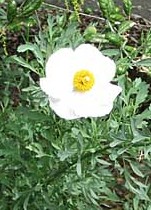 Matilija poppy is a deciduous suckering subshrub native to Southern California and Baja California where it grows and is associated with chaparral and coastal sage scrub plant communities. It is a member of the poppy family, Papaveracae, that also includes bleeding heart, Dutchman’s breeches, and fumatory. In spring, poppy-like flowers 6-8″ across appear singly at the ends of the stems and consists of 6 crepe-paper like petals surrounding a mass of intense golden stamens.The gray-green leaves have a waxy texture and are deeply divided. The woody stems arise from rhizomes that account for the tendency of new plants to pop up all over the area were the mother plant is growing. Matilija poppy is hard to establish and resents being moved but is drought tolerant once it takes hold. Like many other poppies, the plants fade after blooming and can be cut back to three to four inches. The hybrid ‘White Cloud’ has similarly sized flowers but is less rambunctious and therefore more suitable for most gardens. Yes, this plant is also known as the “fried egg plant” but that name does not do it justice. The genus name, Romneya, honors Thomas Romney Robinson (1792-1882)Irish astronomer. The specific epithet, couteri, honors Thomas Coulter, (1793-1843) Irish botanist who collected plants in California and Mexico.
Matilija poppy is a deciduous suckering subshrub native to Southern California and Baja California where it grows and is associated with chaparral and coastal sage scrub plant communities. It is a member of the poppy family, Papaveracae, that also includes bleeding heart, Dutchman’s breeches, and fumatory. In spring, poppy-like flowers 6-8″ across appear singly at the ends of the stems and consists of 6 crepe-paper like petals surrounding a mass of intense golden stamens.The gray-green leaves have a waxy texture and are deeply divided. The woody stems arise from rhizomes that account for the tendency of new plants to pop up all over the area were the mother plant is growing. Matilija poppy is hard to establish and resents being moved but is drought tolerant once it takes hold. Like many other poppies, the plants fade after blooming and can be cut back to three to four inches. The hybrid ‘White Cloud’ has similarly sized flowers but is less rambunctious and therefore more suitable for most gardens. Yes, this plant is also known as the “fried egg plant” but that name does not do it justice. The genus name, Romneya, honors Thomas Romney Robinson (1792-1882)Irish astronomer. The specific epithet, couteri, honors Thomas Coulter, (1793-1843) Irish botanist who collected plants in California and Mexico.
Type: Deciduous flowering subshrub
Outstanding Features: Flowers
Form: Vase-shape
Growth Rate: Rapid
Bloom: Large, solitary flowers 6-8″ across, with petals arranged around a mass of deep gold stamens; in spring
Size: 3-7′ H x 6-8′ W
Light: Full sun
Soil: Average, dry-moderately moist, well-drained
Hardiness: Zones 8-10
Pests and Diseases: Caterpillars, powdery mildew
Propagation: Basal cuttings in spring, root cuttings in winter, seed in spring
Outstanding Selection: ‘White Cloud’ (hybrid).
